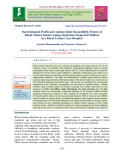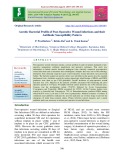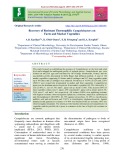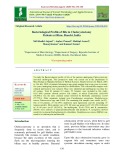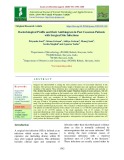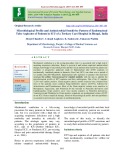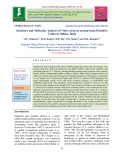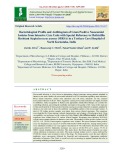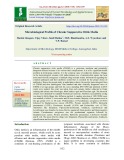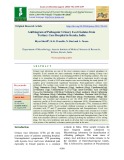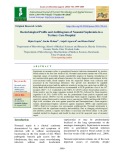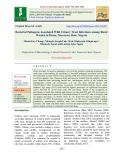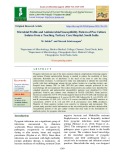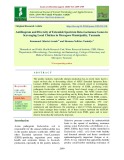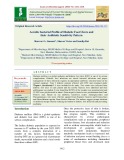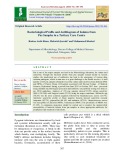
Antibiogram profile
-
Blood stream infections are very common in paediatric age group and are one of the common causes of morbidity and mortality. Septicaemia gradually leads to serious consequences like shock, multi organ failure, DIC etc. Timely identification of causative pathogen by blood culture (gold standard) is important. Antibiogram also helps us to elevate consciousness on resistance problems and recognise prospect to decrease the use of inappropriate antibiotics. The study was undertaken to evaluate major bacterial isolates causing septicaemia and their antibiogram pattern.
 5p
5p  cothumenhmong9
cothumenhmong9
 18-01-2021
18-01-2021
 13
13
 2
2
 Download
Download
-
The objective was to assess the distribution of urinary tract bacterial pathogens and to determine the antibiotic susceptibility profile of the isolates in our setting. Single positive cultures with a colony count of >105 CFU on CLED medium were identified and their antibiotic sensitivity and resistance profile was depicted in the form of an antibiogram.
 7p
7p  gaocaolon9
gaocaolon9
 22-12-2020
22-12-2020
 15
15
 2
2
 Download
Download
-
Post-operative wound infections remain a serious problem in spite of modern standards of preoperative preparation, antibiotic prophylaxis and operative technique. This study was undertaken to Isolate aerobic bacterial pathogens from clinically suspected post-operative wound infections and to determine their antibiogram. Samples that were sent to Microbiology laboratory from clinically suspected cases of post-operative wound infections were processed further.
 16p
16p  angicungduoc8
angicungduoc8
 07-11-2020
07-11-2020
 22
22
 2
2
 Download
Download
-
This study focused on establishing the presence of Campylobacter at the farm and retail level and evaluated the antibiogram profile of isolated species. Campylobacter spp. were isolated on mCCDA agar and confirmed by API Campy (biomereaux, France) and the susceptibility profile determined by Kirby-Bauer disk diffusion method.
 8p
8p  nguathienthan8
nguathienthan8
 20-10-2020
20-10-2020
 9
9
 1
1
 Download
Download
-
To study the Bacteriological profile of bile of the patients undergoing Cholecystectomy and their antibiogram. This prospective study was carried out in the Department of Microbiology at Rajendra Institute of Medical Sciences, Ranchi between 1st March, 2018 to 31st July, 2018, of patients belonging to age group ranging from seven years to seventy five years, undergoing cholecystectomy for cholelithiasis.
 5p
5p  nguaconbaynhay7
nguaconbaynhay7
 15-08-2020
15-08-2020
 12
12
 1
1
 Download
Download
-
Surgical site infection(SSI) is among the most common causes of nosocomial infections in the literature. SSI increases the financial burden, length of hospital stays and significant morbidity and mortality of the patient. These infections have a tremendous impact on morbidity and mortality as SSIs doubled the patient’s risk of death after surgery Therefore despite all recent advances, SSI still continue to be a major problem in the hospitals even with all available modern facilities.
 9p
9p  caygaocaolon6
caygaocaolon6
 30-07-2020
30-07-2020
 19
19
 2
2
 Download
Download
-
Neonatal septicemia is a clinically diagnosed condition having diverse etiology and changing antibiotic sensitivity pattern. The knowledge of common bacterial agents causing septicemia and their antibiogram is useful in deciding empirical antimicrobial therapy. The neonatal blood cultures were studied to know the bacterial species and their antibiotic sensitivity pattern. Aim of the study is to evaluate sensitivity pattern of bacterial isolates causing neonatal septicemia and to know clinical outcome of the cases.
 9p
9p  angicungduoc6
angicungduoc6
 20-07-2020
20-07-2020
 13
13
 1
1
 Download
Download
-
Mechanical ventilation is a life-saving procedure, but it is associated with a high risk of acquiring respiratory infections. Hence to prevent it and initiate empirical antimicrobial therapy, knowledge of microbial profile and their local antimicrobial sensitivity pattern are essential. A prospective analytical study of Endotracheal tube (ETT) aspirates of mechanically ventilated patients in Intensive Care Unit (ICU) was done over a period of six months (Dec2015-May2016).
 5p
5p  chauchaungayxua6
chauchaungayxua6
 26-06-2020
26-06-2020
 18
18
 3
3
 Download
Download
-
Cholera has been reported in the state of Odisha, India since more than two decades. The present study was carried out during the year 2000 to 2004 to find out the incidence and molecular analysis of V. cholerae causing diarrhoea among some primitive tribes namely Bondo, Didayi, Juanga and Kondha residing in Odisha, India. Bacteriological analysis of 1066 rectal swabs collected from hospitalized diarrhoea patients in tribal areas revealed 9.8 % were positive for V. cholerae O1 Ogawa and 3.8% for V. cholerae O139 serogroup.
 11p
11p  nguaconbaynhay6
nguaconbaynhay6
 23-06-2020
23-06-2020
 5
5
 0
0
 Download
Download
-
Central Venous Catheter (CVC) remains a suitable form of vascular access for patients with chronic hemodialysis and has been estimated that almost 30-40% of patients are dependent on CVCs for their vascular access. Aim of the study is to determine the prevalence of Catheter Related Blood Stream Infections (CRBSIs). A Cross sectional study was undertaken after ethical committee approval, Blood samples (5ml-10ml) were collected from catheter site under sterile precautions and Blood Culture (Bac„T‟Alert) performed and isolates grown were identified by routine methods as per standards.
 8p
8p  gaocaolon5
gaocaolon5
 14-06-2020
14-06-2020
 19
19
 0
0
 Download
Download
-
India accounts for 30% of neonatal deaths globally. Bacterial sepsis is a significant cause of morbidity and mortality in newborns. The study helps to make antibiotic policy in neonatal sepsis. The main objective is to study the incidence of multidrug resistant gram negative and gram positive organisms causing neonatal septicemia and their antibiotic sensitivity pattern. The study was conducted in the Department of Microbiology over a period of one year. Sample of blood was collected under aseptic precautions and processed by standard techniques.
 5p
5p  gaocaolon5
gaocaolon5
 14-06-2020
14-06-2020
 19
19
 1
1
 Download
Download
-
Nosocomial infection is a key factor in determining clinical outcomes among patients admitted in intensive care units. Studies on nosocomial infections in ICUs found that respiratory tract infections, blood stream infections, urinary tract infections and soft tissue infections are the common nosocomial infections in ICUs. These organisms causing nosocomial infections are highly resistant to antibiotics. Early recognition of bacteria and appropriate antimicrobial therapy are essential for controlling infection, preventing the morbidity and improve the quality of life.
 11p
11p  angicungduoc5
angicungduoc5
 14-06-2020
14-06-2020
 14
14
 1
1
 Download
Download
-
Chronic suppurative otitis media (CSOM) is a persistent, insidious and potentially dangerous disease because of its various fatal complications. It is still a significant health problem in developing countries. It is the common cause of conductive deafness. Change in the bacteriological scenario with indiscriminate use of antimicrobial agents has been associated with the emergence of multiple drug resistant strains. Information regarding the common pathogens and their antibiotic sensitivities is essential for the proper choice of antibiotics.
 8p
8p  nguathienthan5
nguathienthan5
 04-06-2020
04-06-2020
 26
26
 1
1
 Download
Download
-
Urinary tract infections are one of the most common causes of patient attendance in hospitals. E.coli remains the most commonly isolated pathogen causing Urinary tract infections. Antibiotic resistance is an emerging problem in developing countries. The way ahead is to streamline the utilisation of antibiotics and to implement locally relevant antibiotic policy. A total of 1152 urine samples were received during the study period. 327 samples grew monobacterial significant bacteriuria. Semi-quantitative cultures were performed.
 8p
8p  caygaocaolon5
caygaocaolon5
 27-05-2020
27-05-2020
 11
11
 0
0
 Download
Download
-
Septicemia in neonates refers to generalized bacterial infection documented by positive blood culture in the first four weeks of life. Neonatal septicaemia remains one of the most important causes of mortality despite considerable progress in hygiene, introduction of new antimicrobial agents and advanced measures for early diagnosis and treatment. In this cross-sectional study, blood samples from the suspected infants were collected and processed in the bacteriology laboratory.
 7p
7p  caygaocaolon5
caygaocaolon5
 27-05-2020
27-05-2020
 22
22
 1
1
 Download
Download
-
Drug resistance in bacterial pathogen is an evolving problem requiring monitoring. The study aims at determining the prevalence of bacterial pathogens associated with urinary tract infections in rural women. Urine samples (320) were collected from women in Doma Local Government Area, Nasarawa State and bacteria isolated from the samples. Isolates were identified and serotyping carried out. Antibiogram profile of the isolates was subsequently carried out.
 14p
14p  cothumenhmong5
cothumenhmong5
 17-05-2020
17-05-2020
 16
16
 1
1
 Download
Download
-
Pyogenic infections are one of the most common clinical complications following surgery and trauma. Prompt antimicrobial therapy is needed to reduce the morbidity of these infections. Rationale use of antibiotics is the need of the hour to curb the rising antimicrobial resistance. A retrospective study was undertaken to identify the microbial profile with their antibiogram among the pus culture isolates in a teaching tertiary care hospital from January 2017 to June 2017.504 pus culture samples processed at the microbiology lab were analyzed.
 5p
5p  nguathienthan4
nguathienthan4
 18-04-2020
18-04-2020
 16
16
 0
0
 Download
Download
-
The poultry industry, especially chicken production has in recent times faced a major set-back due to devastating effects of APEC Extended Spectrum BetaLactases (ESBL) producing organisms. This research aimed at investigating antimicrobial susceptibility profile and diversity of ESBL producing avian pathogenic Escherichia coli(APEC) among fecal cloacal swaps of scavenging local chickens based on the various housing systems. The APEC isolates were determined by virulence factor profiling and by Kirby-Baeur disc diffusion, 42% of the APEC isolates were found to be ESBL producers.
 11p
11p  trinhthamhodang1212
trinhthamhodang1212
 06-04-2020
06-04-2020
 12
12
 1
1
 Download
Download
-
Diabetes mellitus is a global epidemic and diabetic foot ulcer (DFU) is one of its serious complications. Diabetic foot infections are mixed bacterial infections and proper management of these infections requires an appropriate antibiotic selection based on the isolated organism. Type 2 diabetic patients affected with DFU and examined under Wagner‘s classification 1-5 were included in the study. Two swabs were collected from diabetic foot ulcer of each patient and the aerobic bacteria were identified and their antibiogram was studied. It was found that 80.
 7p
7p  caygaocaolon4
caygaocaolon4
 01-04-2020
01-04-2020
 13
13
 0
0
 Download
Download
-
us is one of the major samples received in the Microbiology laboratory for culture and sensitivity. Though the bacterial profile from pus samples remain similar in various studies, the inadvertent use of antibiotics has lead to the emergence of various drug resistant pathogens, which in turn acts as a great challenge to the health services.
 8p
8p  trinhthamhodang4
trinhthamhodang4
 22-03-2020
22-03-2020
 17
17
 0
0
 Download
Download
CHỦ ĐỀ BẠN MUỐN TÌM








